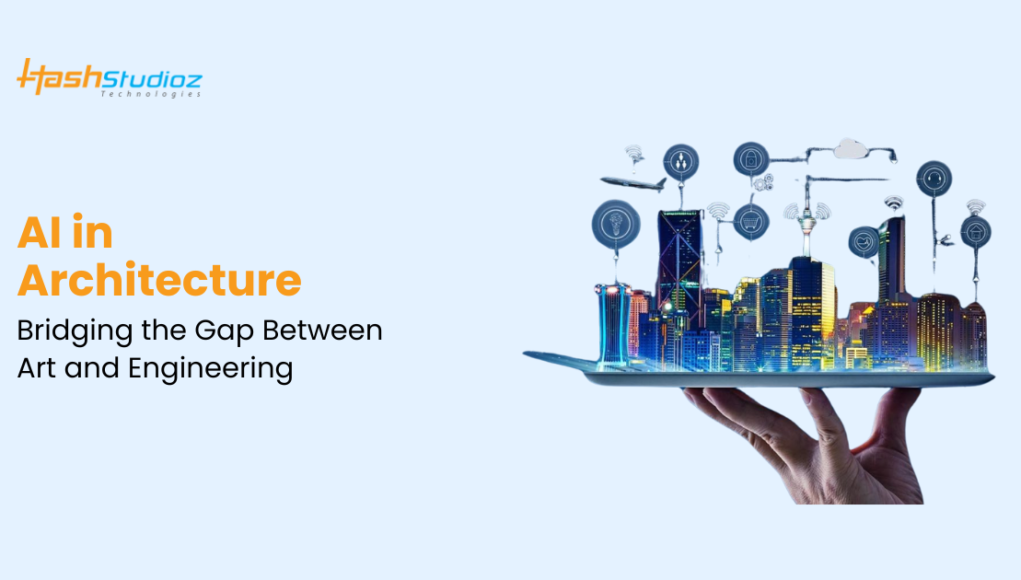The integration of artificial intelligence (AI) into architecture is no longer a futuristic concept but a present-day reality. AI in Architecture is transforming the way we design, plan, and execute architectural projects, serving as a bridge between the artistic aspirations of architects and the precise engineering requirements of construction. This dynamic confluence of creativity and technology is pushing the boundaries of what’s possible in the field, enabling groundbreaking innovations and efficiencies.
From optimizing complex designs to enhancing sustainability and automating construction processes, AI’s potential in architecture is vast. This article delves deep into how AI, along with related fields like machine learning and app development services, is reshaping the architectural and construction industries.
The Evolution of Architecture and Technology
Historically, architecture has been a reflection of cultural, social, and technological advancements. From the simple yet functional mud-brick houses of ancient civilizations to the complex, awe-inspiring structures like the Burj Khalifa, the evolution of architecture has always been intertwined with technological progress.
The current wave of technological transformation comes in the form of AI, machine learning, and app development services. These innovations are enabling architects and engineers to automate repetitive tasks, generate predictive insights, and create designs that were previously unimaginable.
AI in Architecture: A Transformative Force
AI and Design Innovation
AI is a game-changer in architectural design. By analyzing massive datasets, AI algorithms can generate multiple design iterations, optimize layouts, and ensure compliance with building codes and sustainability goals. Key aspects include:
- Generative Design: AI tools like Autodesk’s Generative Design leverage algorithms to create hundreds of design solutions based on specified parameters such as space, materials, and cost. This empowers architects to make informed decisions faster.
- Personalized Spaces: AI can predict user preferences to create tailored environments, such as smart homes or personalized office spaces.
Enhancing Sustainability through AI
Sustainability is a cornerstone of modern architecture. AI is playing a critical role in reducing the environmental impact of buildings by:
- Optimizing Material Use: AI-powered tools can minimize waste by calculating the exact amount of materials needed for a project.
- Energy Efficiency: Machine learning services help architects design energy-efficient buildings by simulating lighting, heating, and cooling scenarios.
- Lifecycle Analysis: AI can predict the environmental footprint of a building throughout its lifecycle, from construction to demolition.
AI in Construction: Revolutionizing the Industry
Automation and Robotics in Construction
AI in construction is introducing a level of precision and efficiency never seen before. Robotics, powered by AI, can perform repetitive and hazardous tasks such as bricklaying or welding, reducing human error and improving safety.
- 3D Printing: AI-driven 3D printing is revolutionizing construction by enabling the creation of intricate structures with minimal material waste.
- Drones and Autonomous Machines: These technologies are used for site surveys, progress monitoring, and material delivery.
Predictive Maintenance and Risk Management
AI systems equipped with predictive analytics help mitigate risks and ensure timely maintenance:
- Risk Assessment: AI tools analyze historical data to identify potential project risks, such as cost overruns or structural weaknesses.
- Maintenance Scheduling: Sensors powered by machine learning services can predict when equipment or infrastructure requires maintenance, reducing downtime.
Artificial Intelligence Services Empowering Architectural Projects
AI is not just a tool but an essential service that supports every phase of an architectural project. Key areas include:
Role of Machine Learning Services
Machine learning, a subset of AI, enables data-driven decision-making. In architecture, it helps:
- Analyze Historical Data: Machine learning algorithms can study past projects to identify patterns and suggest improvements.
- Forecast Project Outcomes: These models predict potential delays or cost overruns, enabling proactive measures.
Data-Driven Decision Making
The use of big data and analytics in architecture has been amplified by AI. Architects now rely on data-driven insights for:
- Urban Planning: AI tools can analyze demographic and traffic data to design smarter cities.
- Design Optimization: AI suggests design improvements by analyzing data from wind tunnels or structural simulations.
App Development Services in Architectural Applications
Smart Design Applications
App development services are bringing architectural tools to handheld devices, making design and collaboration more accessible:
- Design Collaboration Apps: Platforms like BIM 360 enable architects, engineers, and contractors to collaborate seamlessly in real time.
- AI-Driven Design Tools: Apps like Spacemaker use AI to optimize site layouts for sunlight, noise, and wind conditions.
AR and VR in Architectural Visualization
Augmented reality (AR) and virtual reality (VR) are redefining how architects present their ideas:
- Immersive Experiences: VR allows clients to virtually walk through a design, providing a realistic preview of the finished product.
- AR for Construction Sites: AR apps overlay design plans onto real-world environments, improving accuracy during construction.
Ethical Implications and Challenges in AI-Powered Architecture
While the benefits of AI in architecture and construction are immense, they come with ethical considerations and challenges:
- Job Displacement: Automation could lead to job losses in traditional roles, necessitating reskilling.
- Bias in Algorithms: AI systems might unintentionally perpetuate biases present in their training data.
- Data Privacy: Handling sensitive project data requires robust cybersecurity measures.
Future Trends and Innovations in AI in Architecture
The future of AI in architecture promises even greater innovation:
- Digital Twins: Creating virtual replicas of physical buildings for real-time monitoring and simulation.
- AI-Driven Sustainability: Advanced tools for zero-carbon building designs.
- Human-AI Collaboration: A harmonious blend of human creativity and machine intelligence to push the boundaries of design.
Conclusion
AI in Architecture is a transformative force bridging the gap between art and engineering. By integrating AI-driven tools, machine learning services, and app development services, architects and construction professionals are achieving unprecedented levels of innovation, efficiency, and sustainability. However, as we embrace this technological revolution, it is crucial to address the accompanying ethical challenges to ensure a balanced and equitable future.
FAQs
1. How is AI used in architectural design?
AI assists in architectural design through generative design, predictive analytics, and sustainability optimization. Tools like Spacemaker and Autodesk enhance creativity and efficiency by offering AI-driven insights.
2. What is the impact of AI on construction?
AI in construction automates repetitive tasks, improves safety through robotics, and provides predictive maintenance insights, ensuring smoother and more efficient project execution.
3. How do app development services benefit architecture?
App development services facilitate seamless collaboration, enable AI-driven design optimization, and provide immersive visualization tools like AR and VR for architectural projects.
4. What are the ethical concerns of AI in architecture?
Ethical concerns include potential job displacement, algorithmic bias, and data privacy issues. Addressing these requires thoughtful policies and continuous innovation.
5. What is the future of AI in architecture?
The future of AI in architecture lies in innovations like digital twins, advanced sustainability tools, and enhanced human-AI collaboration, promising smarter, more efficient architectural solutions.








